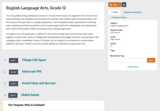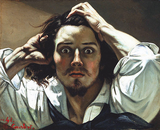
A very comprehensive site that includes a biographical sketch, several texts of Borges'poems, short stories and essays and, critical essays on his works.
- Subject:
- Arts
- English Language Arts
- Material Type:
- Lesson Plan
- Date Added:
- 08/07/2023

A very comprehensive site that includes a biographical sketch, several texts of Borges'poems, short stories and essays and, critical essays on his works.

Discusses what the literary form of drama consists of in relation to its content, language, and structure.

This site on the book "Dandelions" by Eve Bunting, includes a review of the book, a listing of things to notice and talk about, activities related to the book, other related books, and links to other resources.

Site from Ibiblio.org on the exhibit at the Library of Congress in Washington, DC. Contains information on the history of the scrolls, an extensive explanation of each scroll, and pictures.

On this National Archives and Records Administration web site, Stephen E. Lucas describes how the Declaration of Independence is a persuasive piece of literature. Lucus goes into details of the Declaration of Independence studying, at the level of the sentence, phrase, word, and syllable of the entire Declaration.

This is the tenth in a series of articles designed to help the new novel author. This article focuses on how to develop characters through their actions instead of simply relying on dialogue and description of thoughts. W.11-12.3d Sensory/precise lang narratives, W.9-10.3b Narrative techn

The full text of Zane Grey's novel which deals with farming in the Northwest, World War I, and the I.W.W. labor union.

This website is a compendium of letters written by Thomas Carlyle and his wife, Jane Welsh Carlyle, to each other and to others. You can search by date, recipient, or subject.

Describes the themes and writing style of early New England historians. Clicking on the names at the bottom of each page will take you to information about individual historians.

A survey of the Quaker writers from the Colonial period extracted from The Cambridge History of English and American Literature.

This resource is the full text ebook of the novel by Jules Verne.

Site defines the term ambiguity. Offers explanations of different types of ambiguity, quotes and examples.

In this short unit, students will spend three lessons exploring the importance of themes and main ideas in fiction and informational texts. Now would be a good time to have them take an assessment of their reading and writing skills. They'll explore theme through O. Henry's classic short story "The Gift of the Magi" and consider how this piece compares to the main idea in the article "The Proven Power of Giving, Not Getting."

People often say that mankind should learn from history. Charles Dickens, whose books are considered classics, set his novel A Tale of Two Cities in the past. He wanted his readers to learn from the bloody French Revolution and from the widespread brutality in London. Both cities (Paris and London) offer the reader a glimpse into dark and dangerous times. As students read about Dickens's Victorian setting and learn his view of the French Revolution, they will think about what makes a just world. Students will have a chance to think about their own experiences, and, using techniques they have learned from Charles Dickens, they will do some writing that sends a message about your own world.
ACCOMPLISHMENTS
To complete the unit accomplishments, students will:
Read the Charles Dickens novel A Tale of Two Cities.
Read several short pieces, including a biography of Dickens and excerpts from other literature, to help them understand Dickens’s world and the world of the novel.
Explore new vocabulary to build their ability to write and speak using academic language.
Practice close reading and participate in several role plays and dramatic readings to help them experience the dramatic writing style of Charles Dickens.
Write a vignette and a short narrative piece, and practice using descriptive detail and precise language.
Write a reflection about the meaning of Dickens’s novel.
GUIDING QUESTIONS
These questions are a guide to stimulate thinking, discussion, and writing on the themes and ideas in the unit. For complete and thoughtful answers and for meaningful discussions, students must use evidence based on careful reading of the texts.
How does good storytelling affect the reader, and how can a good story promote change in the world?
What was the Victorian view of gender roles?
How can power be abused?
What is loyalty ? What are the limits of loyalty?

The 12th grade learning experience consists of 7 mostly month-long units aligned to the Common Core State Standards, with available course material for teachers and students easily accessible online. Over the course of the year there is a steady progression in text complexity levels, sophistication of writing tasks, speaking and listening activities, and increased opportunities for independent and collaborative work. Rubrics and student models accompany many writing assignments.Throughout the 12th grade year, in addition to the Common Read texts that the whole class reads together, students each select an Independent Reading book and engage with peers in group Book Talks. Language study is embedded in every 12th grade unit as students use annotation to closely review aspects of each text. Teacher resources provide additional materials to support each unit.

This project unit—a multimedia self-portrait published in digital form—is the capstone of your students' high school careers. It is a chance for them to pause and reflect on where they've been, where they're going, and who they are as a person. Students will reflect on what they want others to know about them: what they want their message to be and what types of media they might use to convey that message. Students will have the opportunity to express themselves in many different formats—through writing, of course, but also through other media of their choosing. Students will be able to convey your message through visual art, photography, a graphic novel, audio, poetry, or video—practically any type of media they want!
ACCOMPLISHMENTS
Students will complete a multimedia self-portrait, capturing important aspects of the essence of themselves.
Students will contribute one chapter from their multimedia self-portrait to a class anthology.
Students will present one chapter from their multimedia self-portrait to the class.
GUIDING QUESTIONS
These questions are a guide to stimulate thinking, discussion, and writing on the themes and ideas in the unit. For complete and thoughtful answers and for meaningful discussions, students must use evidence based on careful reading of the texts.
How is late adolescence a moment of internal and external change?
What are the most important qualities of your character—past, present, and future?
How can you portray these key aspects of yourself using multimedia?
BENCHMARK ASSESSMENT: Cold Read
During this unit, on a day of your choosing, we recommend you administer a Cold Read to assess students’ reading comprehension. For this assessment, students read a text they have never seen before and then respond to multiple-choice and constructed-response questions. The assessment is not included in this course materials.

In this lesson, students will take the third in a series of three Cold Write assessments in the narrative genre. The Benchmark Assessment (Cold Write) is an unassisted and unrevised piece of writing with the purpose of providing a quick gauge of the student’s mastery of the characteristics of a given genre. Today’s Benchmark Assessment (Cold Write) measures and provides a benchmark of students’ mastery of narrative writing. Then, they’ll consider the choices artists make when deciding how to portray someone. They’ll also do web research to explore different types of self-portraits.

Why is adolescence a moment of change? How do teenagers experience change in themselves and their surroundings? Students will explore viewing change through five lenses: community, persons, body, events, and choices. Then they’ll look at website-creation or portfolio platforms they can use to publish their projects.

In this 5-day unit, students will explore the topic of love. After reading six poems from writers in the 16th and 17th centuries, they will decide which poet had a better idea than the others about how to express love to a young woman.

The laws that govern and the social norms that regulate society are not always fair, legal, moral, or ethical. What is a person to do about all this injustice? What are the hazards of righting injustices or changing social norms? And what are the dangers of doing nothing?
ACCOMPLISHMENTS
Students read and annotate Antigone, “Letter from a Birmingham Jail,” and Pygmalion.
Students write a literary analysis showing the effect of social class or the law on a character’s life.
GUIDING QUESTIONS
These questions are a guide to stimulate thinking, discussion, and writing on the themes and ideas in the unit. For complete and thoughtful answers and for meaningful discussions, students must use evidence based on careful reading of the texts.
How do social class and legal institutions shape literary characters’ lives (and presumably our lives)?
How does social class affect a person in dealing with the law (protect a person, hurt a person)?
How is social class determined in America and in other places in the world?
BENCHMARK ASSESSMENT: Cold Read
During this unit, on a day of your choosing, we recommend you administer a Cold Read to assess students’ reading comprehension. For this assessment, students read a text they have never seen before and then respond to multiple-choice and constructed-response questions. The assessment is not included in this course materials.